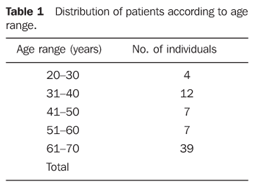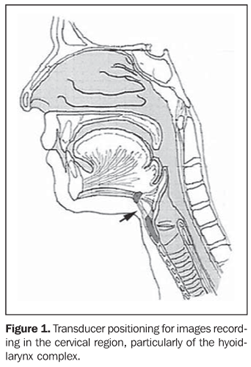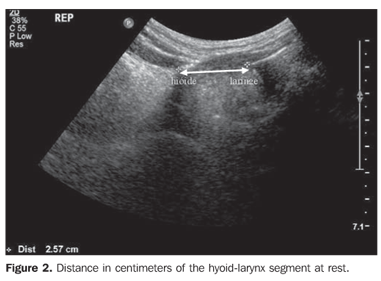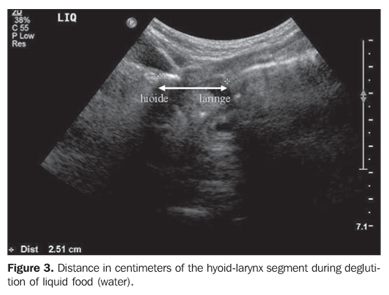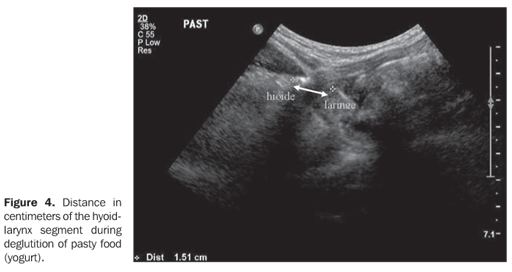Radiologia Brasileira - Publicação Científica Oficial do Colégio Brasileiro de Radiologia
AMB - Associação Médica Brasileira CNA - Comissão Nacional de Acreditação
 Vol. 41 nº 4 - July / Aug. of 2008
Vol. 41 nº 4 - July / Aug. of 2008
|
ORIGINAL ARTICLE
|
|
Sonographic evaluation of swallowing biomechanics: a preliminary study |
|
|
Autho(rs): Cinthya da Silva Lynch, Maria Cristina Chammas, Letícia Lessa Mansur, Giovanni Guido Cerri |
|
|
Keywords: Ultrasonography, Swallowing, Cervical, Dysphagia, Biomechanics, Larynx |
|
|
Abstract:
IFellow PhD degree, Department of Radiology, Faculdade de Medicina da Universidade de São Paulo (FMUSP), São Paulo, SP, Assistant Professor I, Universidade da Amazônia (Unama), Manaus, AM, Brazil
INTRODUCTION Deglutition consists of a sequence of physiological events resulting, after all, in the movement of the food from the mouth into the stomach. According to Bass & Morrell(1), the deglutition process depends on the integrity of a complex neuromotor mechanism and involves a coordinated process that is typically divided into the following phases: oral preparatory (considered as a voluntary phase), pharyngeal and esophageal (considered as reflex phases)(2). According to the American Speech-Language-Hearing Association (ASHA)(3), any alteration in this alimentary transit can be defined as dysphagia. Dysphagia corresponds to a set of symptoms characterized by difficulty in propelling liquid or solid foods from the oral cavity through the esophagus(2,3). Dysphagic problems and their secondary complications are associated with high rates of mortality and morbidity. Deglutition difficulties may occur at any age and affect health and social aspects of feeding. During the deglutition, it is necessary to protect the airways for preventing rinks for aspiration pneumonia(2,4). The baseline laryngeal protective mechanism consists of reflex inhibition of the respiration, closure of the glottic sphincter, anterior laryngeal displacement and elevation, remaining under the tongue protection(4). This displacement contributes to the airways closure and opening of the pharyngoesophageal transition necessary to the protection of the lower airways(4–6). Healthy aging does not cause dysphagia, but the deglutition performance in the elderly is differentiated. Generally, the elderly experiment a decrease in functional reserves of different organs and systems, added of changes in all the deglutition phases(7). In the absence of morbid conditions, the elderly resort to several compensatory strategies such as exerting strength in the deglutition to increase the pressure of the tongue inside the oral cavity, aiding in the food propulsion(8). Imaging methods have attracted the attention of health professionals in areas such as radiology and phonoaudiology, considering the usefulness of these methods in the recording, description and quantification of relevant parameters of the structures involved in the normal deglutition process, as well as in deglutition disorders. Traditionally, videofluoroscopy has been the method of choice for investigating deglutition disorders(5,9). The evaluation of the deglutition by ultrasonography (US) has been utilized for investigating the oral phase(10). The application of this method for investigating the pharyngeal phase was experimented early in the decade of 1990 with the publication of the first studies demonstrating the possibility of visualizing anatomical structures and the movements temporal relationship during the oral and pharyngeal phases of deglutition, such as in the study developed by Miller et al.(11) investigating the application of M-mode ultrasonography during the swallow of two different boluses of food and three deglutition maneuvers. Significant differences were found between duration times in lateral pharyngeal views in the different maneuvers performed. Ultrasonography presents some advantages in the assessment of dysphagia when compared with other traditional diagnostic methods: optimum spatial and temporal resolution in the evaluation of small segments, multiplanar study capability, low cost, equipment portability, besides not requiring contrast enhancement and ionizing radiation(6,12,13). On the other hand, this method presents limitations as compared with videofluoroscopy, considering that a panoramic visualization of the deglutition process cannot be achieved and the access to some pharyngeal structures is restricted(6). It is a role of the specialist to identify the possible clues and the process mechanisms on diagnostic sonographic images. The present study is aimed at investigating the feasibility of ultrasonography in evaluating the deglutition process.
MATERIALS AND METHODS The present study included 39 healthy volunteers (8 men and 31 women) in the age range between 20 and 70 years. The individuals were distributed according to their age range as shown on Table 1. Mean age was 45.56, and the median, 46 years, standard deviation 14.53. All the individuals participating in the present study met the normality criterion required for deglutition function by the test proposed by Logemann for clinical evaluation of dysphagia(2) and by the adapted Cotœs protocol(14).
The following aspects were evaluated in the clinical deglutition test: recent changes in feeding (weight loss, appetite decrease, duration of meals). The following aspects were included in the physical evaluation: muscular tonus, mobility and amplitude of the orofacial musculature, and dental status. Previous history of neurological or neurodegenerative diseases and presence of other direct or indirect factors affecting the deglutition constituted exclusion criteria. A term of free and informed consent was signed by all the individuals. The research protocol was approved by the Committee for Ethics in Research of Hospital das Clínicas da Faculdade de Medicina da Universidade de São Paulo, São Paulo, SP, Brazil. Studies were performed with an ATL HDI 5000 (Philips Medical Systems; Philadelphia, USA) with a multifrequency, convex 2–5 MHz transducer, and a thick layer of hydrosoluble contact gel. During the whole examination, the patient remained in the sitting position, forming an angle of 90º between the buccal floor and the neck, in an attempt to simulate the usual positioning during a meal. The patient was asked to swallow foods of two different consistencies - liquid and pasty - represented respectively by water and yogurt, offered by 10 ml disposable spoons. The food bolus was maintained in the mouth until the patients was verbally asked to start swallowing as usual. The study sequence was recorded in real-time on VHS videotapes. No complication related to the administration of food was observed. The convex transducer was positioned on the cervical region, at the level of the hyoid-larynx complex (Figure 1). Longitudinal images were acquired for measuring the amplitude of movements related to the distance between the upper segment of the hyoid bone and the upper edge of the larynx (thyroid cartilage). At the moment of maximum laryngeal elevation, the measurement of this segment (hyoid-larynx) was performed in centimeters (Figures 2, 3, and 4).
The version 13.0 of the Statistical Package for Social Sciences (SPSS) software was utilized for statistical analysis, considering p = 0.05 as significance level. The Student's t test was utilized for evaluating possible differences between values for male and female individuals, and the Levene's test, for testing the homogeneity of variances. Pearson´s correlation coefficient was applied to evaluate possible correlation between paired measurements.
RESULTS No statistically significant difference was found among mean ages between men and women. Sonographic evaluation of deglutition Comparison between genders in the swallowing of liquid and pasty foods – The analysis of the values obtained by the Student's t test controlled by the Lavene´s test for homogeneity of variances demonstrated a similar behavior both for men and women in the swallowing of liquid and pasty foods. Considering that no statistically significant intergroup difference was found (liquid food, p = 0.785; pasty food, p = 0.460), the authors decided to unify the gender variable. Measurement of the hyoid-thyroid cartilage distance – The measurements of the distance between the hyoid bone and the thyroid cartilage and their correlation with age provided statistically significant results (liquid food, p = 0.175; pasty food, p = 0.011).
DISCUSSION The different physiological aspects of the normal deglutition and dysphagic disorders represent a recent area of interest shared by several health professionals. The management of dysphagia requires the investigation of the deglutition physiology by means of diagnostic imaging methods. The utilization of US as a tool for evaluating the deglutition with emphasis on the easy equipment operation for specific requirements in the investigation of dysphagic disorders, corroborates the results reported by Kuhl et al.(6), who demonstrated significant differences among laryngeal displacements, allowing the utilization of this method. Despite the imbalance in the number of male and female individuals included in the sample of the present study, the US evaluation demonstrated a small standard deviation. The previous clinical examination demonstrated normality in anatomical and functional aspects of the organs and systems involved in the deglutition. Specific age-related signs, such as decrease in laryngeal elevation, could not be detected during the clinical examination, requiring an objective evaluation by US. With aging, there is a decrease in muscular mass, tonus and strength. The elderly performance in the present study may have been influenced by driven attention status (voluntary deglutition), including the increase in the strength of food propulsion among other mechanisms, similarly to results reported by Logemann et al.(13) and Kays & Robbins(7). Even with the attention level under control, the individuals presented a performance in pasty food deglutition demonstrating a significant positive correlation with age. Despite their satisfactory functional levels, the elders present different performance levels as compared with the levels achieved by the other individuals in de sample, in agreement with some authors(6–8). This information should be taken as a relevant warning to health professionals, considering that, frequently, the utilization of pasty foods is proposed in the adaptation of food consistency for the elderly with deglutition difficulties, because of the generally diffused idea that this consistency is more easily processed in the oral phase. There are still few studies approaching the utilization of US in the deglutition evaluation(15). The present study is a pilot for future initiatives involving comparison with other results obtained with videofluoroscopy. Promising suggestions for utilization of US in deglutition studies include temporal measurements in order to allow the observation of structures temporal and spatial relationships, and inference of integrity or impairment of airways protective mechanisms, as well as the utilization of the equipment as a monitoring resource in speech and language therapies. Images suggesting the presence of food remainders, penetration, food aspiration, as well as the presence of protuberant thyroid cartilage impairing the acquisition of images constitute limiting factors in the US evaluation of the deglutition.
CONCLUSION Ultrasonography has allowed the evaluation of the deglutition functionality as well as its variation with aging, representing a complementary resource in the evaluation of possible alterations in the swallowing process. Sonographic studies can be useful in the detection of direct effects on the rehabilitation process with the adoption of specific postural and protective maneuvers, as well as changes in foods consistency, allowing a better management of dysphagia.
REFERENCES 1. Bass NH, Morrell RM. The neurology of swallowing. In: Groher ME, editor. Dysphagia: diagnosis and management. Boston: Butterworth-Heinemann; 1992. p. 1–31. [ ] 2. Logemann JA. Evaluation and treatment of swallowing disorders. 2nd ed. Austin: Pro-Ed; 1998. [ ] 3. American Speech-Language-Hearing Association. Instrumental diagnostic procedures for swallowing. Ad Hoc Committee on Advances in Clinical Practice. ASHA Suppl. 1992;34(Suppl. 7):25–33. [ ] 4. Costa MMB. Como proteger fisiologicamente as vias aéreas durante a deglutição. In: Castro LP, Savassi-Rocha PR, Melo JRC, et al. Tópicos em gastroenterologia 10 – deglutição e disfagia. Rio de Janeiro: Medsi; 2000. p. 37–48. [ ] 5. Leonard RJ, Kendall KA, McKenzie S, et al. Structural displacements in normal swallowing: a videofluoroscopic study. Dysphagia. 2000;15: 146–52. [ ] 6. Kuhl V, Eicke BM, Dieterich M, et al. Sonographic analysis of laryngeal elevation during swallowing. J Neurol. 2003;250:333–7. [ ] 7. Kays S, Robbins J. Effects of sensorimotor exercise on swallowing outcomes relative to age and age-related disease. Semin Speech Lang. 2006; 27:245–59. [ ] 8. Hind JA, Nicosia MA, Roecker EB, et al. Comparison of effortful and noneffortful swallows in healthy middle-aged and older adults. Arch Phys Med Rehabil. 2001;82:1661–5. [ ] 9. Bilton TL. Estudo da dinâmica da deglutição e das suas variações associadas ao envelhecimento, avaliadas por videodeglutoesofagograma, em adultos assintomáticos de 20 a 86 anos [Tese de Doutorado]. São Paulo: Universidade Federal de São Paulo; 2000. [ ] 10. Chi-Fishman G. Quantitative lingual, pharyngeal and laryngeal ultrasonography in swallowing research: a technical review. Clin Linguist Phon. 2005;19:589–604. [ ] 11. Miller JL, Watkin KL. Lateral pharyngeal wall motion during swallowing using real time ultrasound. Dysphagia. 1997;12:125–32. [ ] 12. Huckabee M, Hiss S, Barclay M, et al. The relationship between submental SEMG measurement and pharyngeal pressures during normal and effortful swallowing. Dysphagia. 2005;20:73. [ ] 13. Logemann JA, Pauloski BR, Rademaker AW, et al. Temporal and biomechanical characteristics of oropharyngeal swallow in younger and older men. J Speech Lang Hear Res. 2000;43:1264–74. [ ] 14. Cot F. Évaluation de la déglutition. In: Cot F, editor. La dysphagie oro-pharingée chez l'adulte. Québéc: Maloine-Edisem; 1996. p. 79–99. [ ] 15. Santos RS, Macedo Filho ED. Sonar Doppler como instrumento de avaliação da deglutição. Arq Int Otorrinolaringol. 2006;10:182–91. [ ] Received May 8, 2007. Accepted after revision January 24, 2008. * Study developed at Instituto de Radiologia do Hospital das Clínicas da Faculdade de Medicina da Universidade de São Paulo (InRad/HC-FMUSP), São Paulo, SP, Brazil. Financial support: Universidade da Amazônia (Unama) – Fundação Instituto para o Desenvolvimento da Amazônia (Fidesa). |
|
Av. Paulista, 37 - 7° andar - Conj. 71 - CEP 01311-902 - São Paulo - SP - Brazil - Phone: (11) 3372-4544 - Fax: (11) 3372-4554
